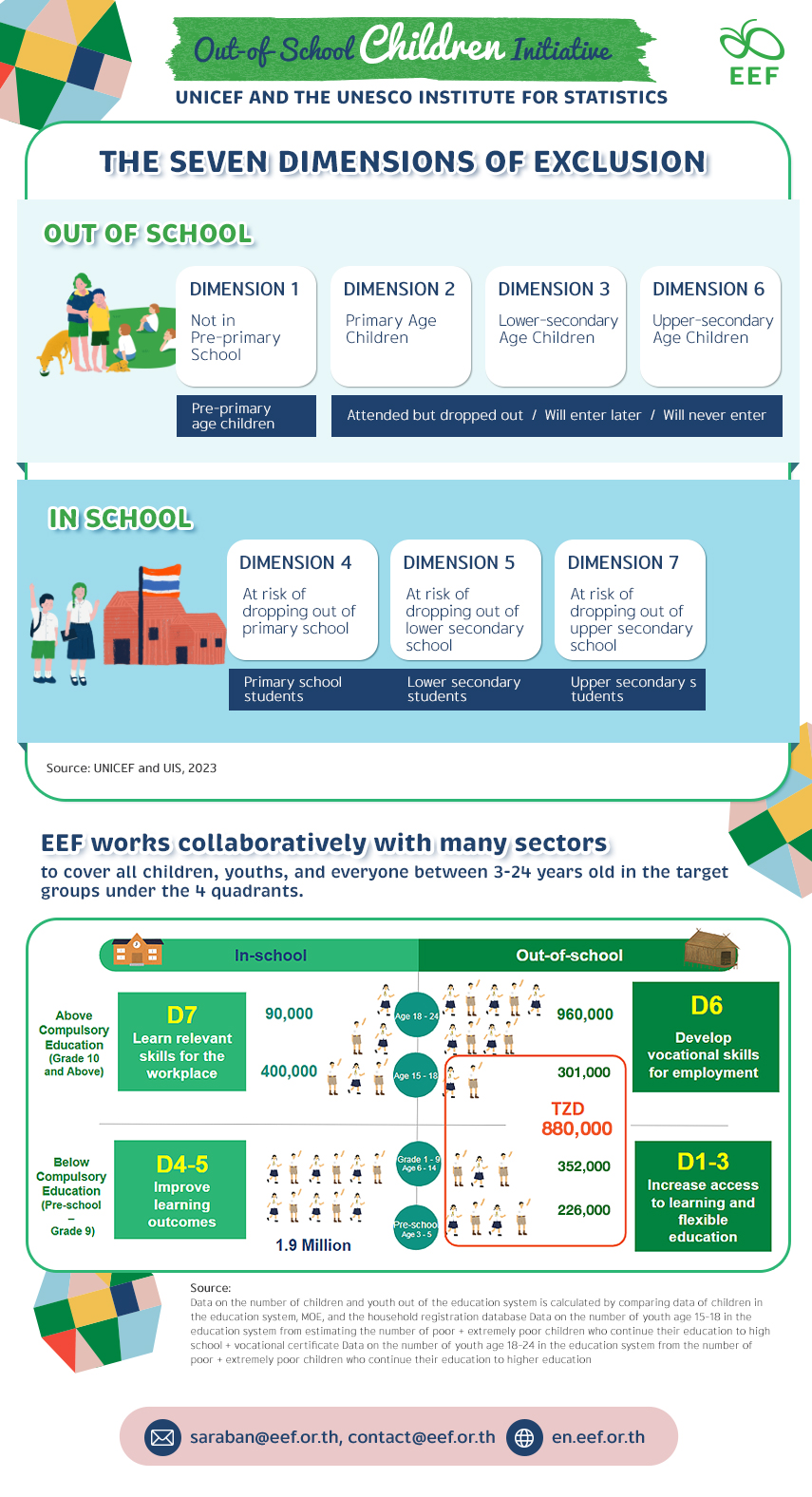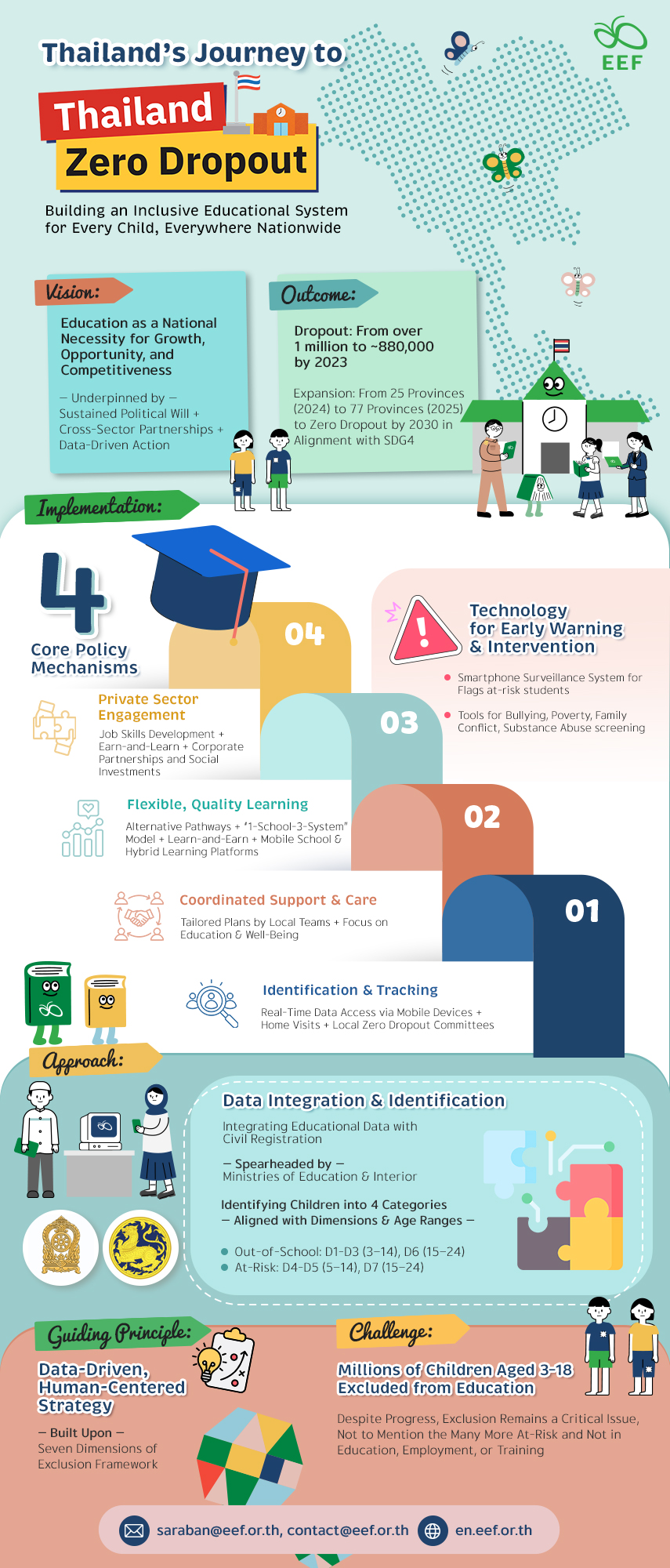
What happens when a country with global ambitions discovers its greatest untapped resource lies not in factories, but in classrooms its children may never enter? Thailand’s long-held bid to break free from the middle-income trap hinges upon a silent crisis: the persistent exclusion of its children and youth from education. Whether out-of-school, at risk of dropping out, or disengaged from education, employment, or training altogether, these young individuals are not just a moral concern; they are a brake on progress. Without a system that reaches, supports, and equips every child to thrive, Thailand risks losing an entire generation of “Lost Einsteins”—those innovators, workers, and citizens, both would-be and would-have-been, had they only been given the chance. No longer enough is incremental reform enough; imperative is nothing short of a fundamental system change in access, equity, and opportunity, and at scale.
In the first of this two-part article series, Dr. Kraiyos Patrawart, Managing Director of the Equitable Education Fund (EEF) Thailand, revealed how adopting an international framework built on seven dimensions of exclusion has provided a powerful foundation for understanding this vast challenge. He also shared the strategic steps underway to identify, reach, and reintegrate out-of-school children nationwide.
When nearly a million children are missing from classrooms, the question is not just “where are they?”Rather, it is “What are we doing about it?” Thailand, as it turns out, is doing quite a lot. Rising to the challenge, it has placed educational inclusion at the forefront of national priorities. Leading this effort is the Equitable Education Fund (EEF) Thailand, which employs a data-driven, human-centered strategy, an approach that exemplifies the kind of systemic transformation more urgently needed than ever. Central to its approach is the international framework, which encompasses seven dimensions of exclusion, offering a comprehensive perspective on the multiple barriers children face. Four dimensions address children completely outside the educational system—those who never enrolled, dropped out, or were unrecorded—while the remaining three focus on enrolled students at high risk of leaving.

To bring this framework into practice, the EEF has partnered with the Ministry of Education (MOE) and the Ministry of Interior (MOI) to merge civil registration with educational data. This integration allows precise identification of individuals, aged 3 to 24, both in and out of school, across the country. The data sorts children into four groups aligned with the seven dimensions: two for out-of-school children—D1 to D3, covering ages 3 to 14, and D6, covering ages 15 to 24—and two for in-school, at-risk students—D4 to D5 for ages 5 to 14, and D7 for ages 15 to 24. What was once a vague statistic now becomes a human-centered problem, complete with individual names, places, circumstances, and faces, allowing targeted, effective solutions.
This issue—the large number of children out of school—remains one of Thailand’s most urgent educational challenges. Despite progress in expanding basic educational access, nearly 880,000 children between 3 and 18 are still excluded. To address this, the EEF has launched the “Thailand Zero Dropout” initiative, initiated by former Prime Minister Srettha Thavisin. The Cabinet aims to scale efforts from 25 provinces in 2024 to all 77 by 2025, targeting zero dropout by 2030 in line with Sustainable Development Goal 4—all to turn Thailand into a land of opportunity for everyone, with equity and equality, as officially declared in its national agenda.
Notably, in 2024, the Cabinet approved a resolution to tackle this challenge head-on, assigning agencies four core policy mechanisms. First, to identify out-of-school children and youth by linking data from relevant agencies to civil registration numbers, locating every child, enrolled or not, by name and address. This has enabled schools, local authorities, and community volunteers to access real-time data via mobile devices, allowing them to conduct home visits and understand the reasons behind absences. These localized efforts are coordinated by provincial “Zero Dropout Committees,” led by governors, spearheading their local knowledge and resources.
Second, the resolution has mandated coordinated follow-up, assistance, referral, and care. Local teams—teachers, administrators, social workers—offer tailored support addressing each child’s education, well-being, living conditions, and social context. The goal is not immediate universal return to school, but rather ensuring every child has a viable, supported plan for future learning, whether through formal or alternative pathways. This approach has already reduced out-of-school numbers significantly, with further gains expected. By 2023, the number of out-of-school children dropped from over one million to approximately 880,000, a measurable achievement that nonetheless underscores the work ahead.
Third, the Cabinet has endorsed flexible, quality learning management tailored to individual potential. Alternative pathways, especially at higher education levels, have now enabled students to “Learn and Earn” simultaneously. The “1-School-3-Models” model, for example, places education at the center, with work experience integrated concurrently—all accredited through unified transcripts and the Credit Bank, which captures learning across formal schooling, internships, and workplace training to support smoother transitions into higher education or employment. Moreover, mobile schools and hybrid learning platforms have extended reach to remote and marginalized populations.
Fourth, private sector engagement has been incentivized to support youth aged 15–18 in developing job skills aligned with labor market demands—a flipped “Learn and Earn” model, in which income generation now takes precedence while education continues concurrently. Corporate social investments, such as Sansiri’s 100 million Thai Baht social bond and KFC’s flexible learning for juvenile justice youth, exemplify impactful models of reintegration back into school, society, and employment. These collaborations reflect Thailand’s commitment to systemic, inclusive, and sustainable educational reform, ensuring not only that every child returns to school, but also that each one finds a pathway to learning, growth, and opportunity, —supporting education while building skilled workforces.
Furthermore, to reinforce these efforts, the EEF has harnessed technology to tackle non-economic dropout risks, such as bullying, poverty, family conflict, and addiction. A smartphone-based surveillance system, now being scaled nationwide, has enabled teachers to flag at-risk students through real-time dashboards shared with school and district officials. With integrated tools for poverty screening, background checks, and psychosocial risk indicators like domestic violence or substance abuse, this system has facilitated timely interventions that can make the difference between staying in school and dropping out.

Together, these interventions form a dynamic, integrated response to Thailand’s out-of-school crisis—one that moves beyond surface-level fixes to confront the deeper causes of educational exclusion. The EEF’s strategy is both systematic and human-centered, recognizing that each learner faces distinct challenges shaped by their environment. By combining precise data systems, localized efforts, flexible learning pathways, and private sector engagement, this approach breaks down structural barriers while restoring faith in the educational system. Crucially, it redefines educational access not as charity, but as necessity, central to economic competitiveness, social equity, and long-term development.
With sustained political commitment, strong cross-sector partnerships, and smart use of data and technology, Thailand is not just reducing dropout; it is building an inclusive, adaptive, and opportunity-rich learning ecosystem. If realized, this vision could transform Thailand from a country at risk of leaving its children behind into one where every child is equipped to move forward, educated, empowered, and ready to lead. The next article will explore how flexible education pathways and cross-sector collaborations keep at-risk youth engaged in learning, laying the foundation for the nation’s prosperity and its escape from the middle-income trap by turning classrooms into engines of opportunity.
All For Education is all about people; only when all is in for education is Education For All. Join the movement to reduce educational inequality. Support the EEF by donating to fund research, partnerships, and assistance for children, youth, and adults in need of educational support. Click the link to contribute today and help create a society where education is open and equal for all. Together, we can make a lasting impact.

